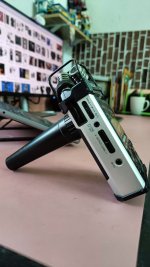I don't think things are not quite that simple.
To use a poor analogy, we could consider that a mic is like a camera lens, where the sensitivity equate to the focal length and the directional performance of the mic, the field of view. In this analogy, gain could be considered to be like exposure (control of shutter speed and lens aperture). With 32 bit float, it would then be the equivalent of not having to bother to control exposure, it would be impossible to have a under or over exposed photo, and everything could be sorted out on your computer after taking the photo. It would not be the same as having an photo with a vast number of pixels that you could blow up to your hearts content.
This analogy is not really right, but would you buy a camera and lens to take a pictures of birds, if you didn't even know the focal length of the lens?
In reality the mic will turn sound into a an electrical signal that the recorder converts and saves in digital formal. The signal from the mic will depend on the specification for the mic (sensitivity, directional, self noise etc.), ambient noise from the recording environment and the strength of the bird vocal (generally how close you area). This mix of signal and noise is 'locked in', and cannot be altered by 32 bit float technology. So if you have a distant bird, a low sensitivity mic and/or noisy mic, and/or a noisy environment, the ratio of signal to noise will be poor come what may. Generally the closer you are to a bird the better the signal to noise ratio.
The bit rate of a recorder defines the quietest thing that can recorded. The bigger the bit rate number the quieter the limit. If you make a mess of the gain and set it far too low, the quieter elements of the signal from the mic may be even quieter than this limit (you would need a bigger number than possible to digitally record the very quite sound). In this case the quite detail cannot be recorded as and you loose this detail. If you try and reset the level afterwards, you can never replace this lost detail and all you do is amplify the noise floor (the quietest thing you can record). With 32 bit float, the noise floor is much quieter, so if is virtually impossible to loose signal below the noise floor (the equivalent of the photo not being able to be under exposed). But also as with a float representation, the number it can be negative as well as positive. With 16 and 24 bit, the noisiest thing you can record would have a value of zero, but with 32 bit float you can have negative numbers to represent even louder sound. This means that whereas you can loose parts of a 16 or 24 bit recording by setting the gain too high (and introducing clipping), with 32 bit float you can save such recordings in post, as the extra loud bits have not actually been lost, but recorded as negative values - of course you need to correct the levels in post, before you can play the file without distortion (the equivalent of the photo not being able to be over exposed).
With all-in-one recorders, there is general lack of detail on what you are buying. What is the sensitivity or the mic, what is the directional performance, what is the self noise?. Without this information only really trial and error can confirm what recorders work best for recording of birds. A bit of a cop out, but you either need to
- take a risk and buy something and hope for the best,
- find a nice shop where you can perhaps try before you buy (at least in the store), or where staff may be familiar with the device and its pros and cons and can provide expert advice, or
- find someone who is using the device already for the same purpose and is willing to provide impartial advice.
Zoom actually do provide more details than most on their all-in-one recorders. Most of their 32 bit float recorders do not have built in mics (F2, F3, F6, F8N Pro). The ones that do seem to have pretty quite mics
- M2 (−42 dB/1 Pa at 1 kHz)
- M3 (unspecified)
- M4 (−42 dB/1 Pa at 1 kHz)
- H1 Essential (–43 dB/1 Pa at 1 kHz)
- H4 Essential (–43 dB/1 Pa at 1 kHz)
- H6 Essential (−42 dB/1 Pa at 1 kHz)
If we make a rather unfair comparison with a Rode NTG5 shotgun, the sensitivity of that mic -23.5 dB re. 1 Volt/Pascal or Better (66 mV @ 94 dB SPL @ 1 kHz). The lower the figure the more sensitive the mic. I think -42 dB/1 Pa at 1kHz is pretty quite, and that teh devices are therefore probably designed for recording fairly strong signals up close (say a band of an interview). The sensitivity is the equivalent of 7.9433mV dB SPL @ 1 kHz, so the voltage received by the recorder will be 8 x less than from the Rode mic!
I say this is unfair, but their are lots or mics much more sensitive than -42dB/1 Pa - A Clippy EM272 Lavalier mic has a sensitivity of -28dB (39.8mV).
Sensitivity is of course not always a good thing, as despite how directional a mic is, you will generally pic up more unwanted ambient noise (particularly low frequency, which cardiodal and super-cardiodal (shutguns) mics are generally poor at rejecting). We then get back to getting a close as possible being a good option, and at least with 32bit gloat all-in-one recorders, you can potentially conceal the recorder close to a bird with record on, and no worries about gain settings.






